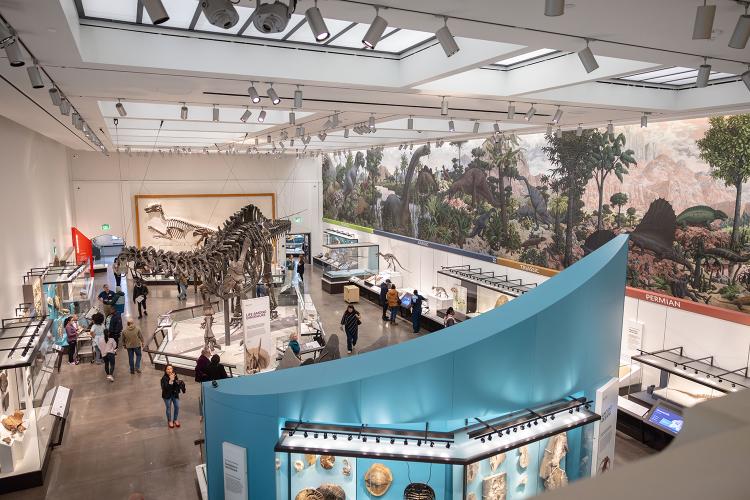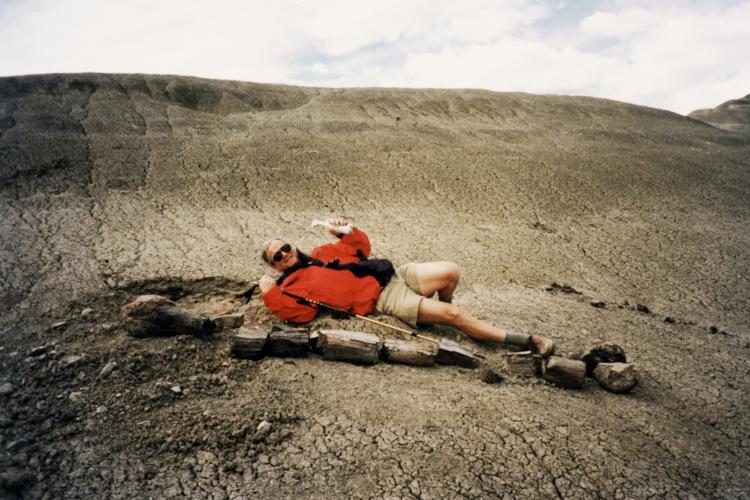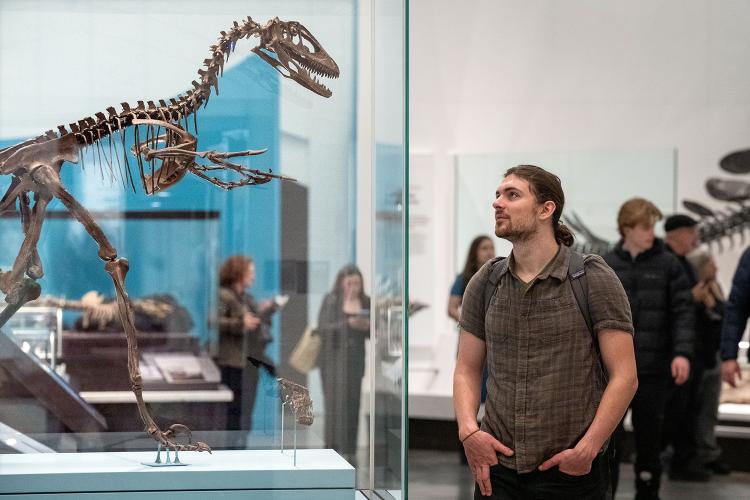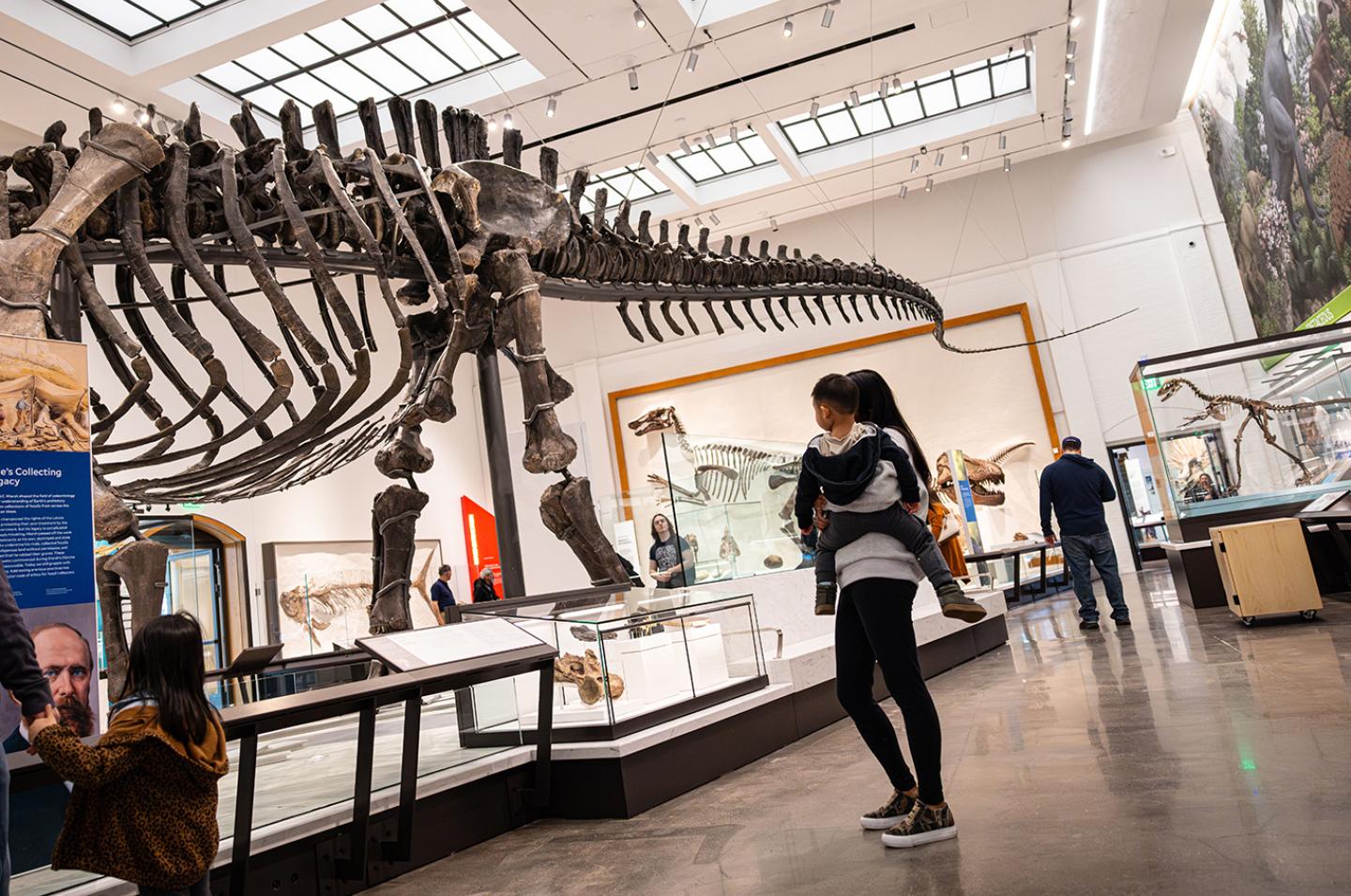After four years of renovations, the Yale Peabody Museum is open once again. Visitors will find it transformed, with fifty percent more exhibition space, updated displays, and purpose-built spaces for teaching and object study. At the heart of the museum is the iconic Brontosaurus, dominating a reimagined dinosaur hall. Completely cleaned and remounted in a natural pose, the massive specimen appears ready to step off of its pedestal, its head soaring above visitors and its tail stretched out whip-like to the far corner of the room. Above, the beloved Age of Reptiles mural, painted by Rudolph Zallinger ’42 BFA, ’71 MFA, has been meticulously cleaned and restored.
The hall has “gotten the makeover it deserved,” says David Skelly, director of the Peabody Museum and Frank R. Oastler Professor of Ecology at the Yale School of the Environment. That’s thanks in large part to a gift from Coleman P. “Coley” Burke ’63, made via the Coleman and Susan Burke Foundation. Now named the Coleman P. Burke Hall of Dinosaurs, the museum’s marquee space will continue to inspire generations of current and future visitors.

Honoring a Natural History Enthusiast
Burke, who died in 2020, had a longstanding passion for natural history. His New York City office featured a life-size replica of the Chicago Field Museum’s T. rex skull, along with a reproduction of the Zallinger mural.
“He loved Yale and was very proud of Yale. He loved paleontology and was a very big enthusiast about history in general—the older the better,” says Burke’s daughter Lisa Burke Whitescarver ’89.
“Coley had a fascination with the prehistoric past, and he was very knowledgeable,” adds Skelly. “The fact that the world was so different, and that these incredible animals were everywhere, just blew his mind, as it does mine.”

Reimagined and Reanimated
Alongside its impressive dinos, Burke Hall now presents a timeline of organisms from Earth’s early oceans through the evolution of life on land, highlighting specimens from the museum’s extensive sea scorpion fossil collection. Large red markers through the hall denote mass extinction events, explaining the cause and the life forms that those extinctions gave rise to.
The hall’s Stegosaurus skeleton has also been remounted into a more dynamic pose. And both the Brontosaurus and the Stegosaurus have undergone tweaks to their tails, based on research done at the Peabody and elsewhere: the Brontosaurus now has more vertebrae, and the Stegosaurus’s tail has four fewer spikes. While the mural has not been modified, it’s now contextualized with information explaining scientists’ current understanding of how dinosaurs moved. Once considered “slow, stupid, and tired” beasts, dragging their tails along behind them, says Skelly, scientists now know that many dinosaurs were smart, highly capable, and agile.
Erik Burke notes that his father was a star hockey player at Yale. “I often think that there was some connection between dinosaurs and hockey players for him, with their ferociousness and their agility and their speed,” he says.
In 2013, Burke supported the acquisition of a mosasaur skeleton, now featured in the Peabody’s new Central Gallery. Above visitors’ heads, it “swims” in perpetual pursuit of Archelon, the largest turtle ever discovered. Burke traveled extensively in Patagonia, including with his wife Susan Payson Burke, participating in fossil expeditions and financially supporting others—one of which resulted in the discovery of a new species of theropod. (The Peabody’s Deinonychus, which was the inspiration for Jurassic Park’s velociraptors, is also a theropod). The species is named Orkoraptor burkei in his honor. Another expedition he supported discovered a new species of crocodile, Burkesuchus mallingrandensis, one of the few crocodiles that coexisted on land with dinosaurs. “The idea of the dinosaurs really captivated him,” says Susan Burke. “The hall is such a wonderful monument to him.”

A Lasting Legacy of Accessibility and Exploration
“For our dad to be able to combine his love for Yale with his love for dinosaurs made him so happy,” says Erik Burke. “He can look down on Burke Hall and say, ‘That’s the crossroads of two of the biggest loves of my life.’ That means a heck of a lot to our family.”
Burke’s legacy at Yale extends beyond the Peabody. At the School of the Environment (YSE), he created an endowed fund to bring climate experts to the school as visiting professors. Burke Auditorium, in YSE’s Kroon Hall, is a gathering place for classes, speakers, ceremonies, and celebrations.
Burke’s contribution to the Peabody was his last gift to Yale and was especially meaningful to him. “It’s hard for everyone to take a flight to Patagonia,” says his daughter Sarah Honeyman. “But the Peabody is super accessible. He would be so proud to know all the joy it’s going to bring people.”
“Our dad believed deeply in the mission of the Peabody: to advance our understanding of the natural world and bring that understanding to a broad audience,” adds his daughter Lisa. “He believed in looking way into the past using cutting-edge science, and nobody does that better than Yale.”
